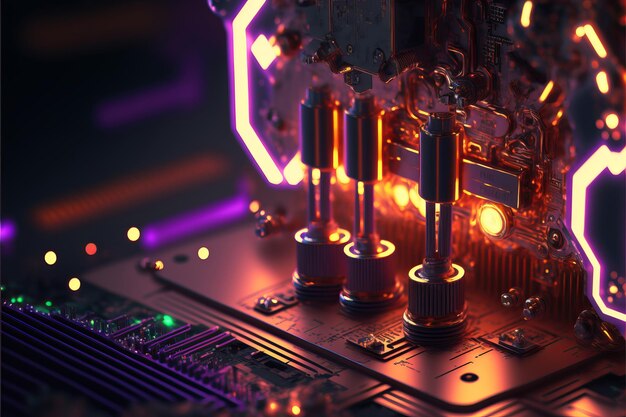Conclusion
style=”text-align: justify;”>As ai continues to advance and transform various industries, the role of supercomputing in its development becomes increasingly significant. From processing large datasets to simulating complex systems, supercomputers provide valuable resources for researchers and developers pushing the boundaries of ai technology. However, it is crucial that we address the limitations of current supercomputing technologies to ensure sustainable progress and growth in this field.

The Role of Light in Computing: Optical Computing
Optical computing is an innovative approach to information processing that utilizes light instead of electrons. This branch of technology has a rich history and holds great promise for the future, particularly in the realm of Artificial Intelligence (AI) supercomputing.
Definition and history of optical computing
Optical computing, also known as photonic computing, is a non-traditional method of data processing that uses light instead of electricity. Its origins can be traced back to the late 1960s, when researchers first began exploring the possibilities of all-optical signal processing. Since then, advancements in materials science and photonics have led to significant progress in this field.
Principles of optical computing
Differences between electronic and optical computing: While electronic computing relies on the flow of electrons to represent and manipulate data, optical computing uses photons, which are particles of light. The primary difference lies in their interaction with matter: electrons interact electrically through voltages and currents, while photons interact optically through reflections, refractions, and interference.
Light manipulation using waveguides, photodiodes, and modulators:
In optical computing systems, light is guided through waveguides made of transparent materials such as silicon or fiber optic glass. Photodiodes, which convert light into electrical signals, are used to detect changes in optical signals. Modulators, on the other hand, alter the properties of light (such as its phase or polarization) in response to electrical signals.
Advantages of optical computing in AI supercomputing
Faster processing speeds: Light travels much faster than electricity, making optical computing systems potentially capable of processing information at significantly higher speeds than their electronic counterparts. This is particularly important for AI applications that require large amounts of data to be processed quickly and efficiently.
Reduced energy consumption:
Another key advantage is the reduced energy requirements of optical computing. Since photons carry their own energy, they do not require external power sources to move through waveguides and interact with each other – a significant difference from the energy-intensive process of moving electrons in electronic circuits.
Increased parallelism and scalability:
Optical computing also offers increased parallelism, as multiple signals can be processed simultaneously using the same waveguides. Additionally, it is more scalable due to its three-dimensional nature, allowing for dense integration of components within a single chip or system.
I Technologies and Applications in Optical AI Supercomputing
Photonic Neural Networks (PNNs)
Photonic neural networks (PNNs) are a promising area of research in optical AI supercomputing. The design, architecture, and components of PNNs differ significantly from their electronic counterparts.
Components of PNNs:
a) Input/Output layers: Input and output layers are typically implemented using modulators that convert electrical signals to optical signals for processing.
b) Processing units (photon switches): PNNs use photon switches, which are devices that can manipulate the path of a photon based on optical signals.
c) Weights and biases representation using optical components: In PNNs, weights and biases are represented using optical components such as spatial light modulators (SLMs) or Mach-Zehnder interferometers.
Training methods for PNNs:
Training methods for PNNs are still an active area of research. Techniques such as backpropagation with intensity modulation and phase modulation have been proposed to train these networks.
Other optical AI supercomputing technologies:
Beyond PNNs, there are other optical AI supercomputing technologies that show great promise. These include:
1) Optical tensor processing units (OPTUs):
OPTUs are designed to perform tensor operations, which are crucial in deep learning models. They use optical elements to implement matrix multiplications and other tensor operations more efficiently than electronic processors.
2) Optical deep learning processors (ODLPs):
ODLPs are designed to accelerate the training and inference of deep learning models using optical components. They typically consist of a large array of photon switches and other optical elements that can implement various operations needed in deep learning, such as convolutions and dot products.
Applications of optical AI supercomputing:
Optical AI supercomputing has the potential to revolutionize various applications, including:
1) Image and speech recognition:
Optical AI supercomputing can process massive amounts of data in parallel, making it ideal for image and speech recognition tasks. For instance, Google’s Brain team is working on using photonic neural networks for image recognition.
2) Natural language processing:
Optical AI supercomputing can also be used for natural language processing tasks, such as machine translation and sentiment analysis. The high-speed parallel nature of optical processors makes them suitable for handling the complexities of natural language data.
3) Scientific simulations and modeling:
Optical AI supercomputing can significantly speed up scientific simulations and modeling. For instance, it has been suggested that photonic neural networks could be used for simulating quantum systems more efficiently than current electronic computers.
In conclusion,
Optical AI supercomputing is an exciting and rapidly evolving field that promises to revolutionize various applications through the use of photonic neural networks, optical tensor processing units, and other advanced technologies. These systems offer significant advantages over traditional electronic processors for tasks that require massive parallelism and high-speed data processing.
References:
Carnegie Mellon University: Optical Neural Networks link
Google Research: Photonic Neural Networks link
Intel: Optical Tensor Processing Units link
MIT Technology Review: Optical Deep Learning Processors link

IV. Current Research and Development in Optical AI Supercomputing
Ongoing projects and collaborations
- European Human Brain Project (HBP): This ambitious initiative involves the development of a next-generation supercomputing platform for brain simulation, including a significant focus on optical AI supercomputing.
- Photonics 21 initiative: A public-private partnership, Photonics 21 aims to support research and innovation in the field of photonics, including optical computing for AI applications.
Progress and challenges in the field
1. Advancements in photonic materials and components: Recent years have seen significant progress in the development of advanced photonic materials, such as silicon nitride and gallium arsenide, which are essential for creating high-performance photonic devices. Furthermore, the miniaturization of these components is crucial for integrating optical computing with electronic circuits.
2. Integration of optical computing with electronic circuits: Combining the strengths of both optical and electronic systems is crucial for creating a powerful AI supercomputer. Current efforts include developing hybrid photon-electron interfaces and designing efficient data converters to enable seamless communication between the two systems.
3. Development of new architectures and algorithms for optical AI supercomputing: Novel architecture designs, such as crossbar and neural networks, are being explored to optimize the performance of optical systems in machine learning tasks. Furthermore, the development of specialized algorithms tailored for optical computing can significantly enhance their potential applications.
Future directions and opportunities
- Quantum computing integration with optical supercomputing: The fusion of quantum computing and optical supercomputing presents an intriguing opportunity for achieving unprecedented computational power, enabling breakthroughs in various scientific and industrial domains.
- Advancements in machine learning for optical systems design and optimization: The application of machine learning techniques to optimize the design, configuration, and operation of optical systems can lead to significant improvements in their overall performance and efficiency.

Conclusion
Summary of the Potential Benefits and Challenges of Optical AI Supercomputing: Optical AI supercomputing, with its promise of faster data processing and lower power consumption compared to traditional electronic supercomputers, has the potential to revolutionize various industries. It could significantly reduce the time required for complex computations in fields such as scientific research, climate modeling, and machine learning. However, challenges exist, including the development of efficient optical algorithms and integrating them with existing hardware and software infrastructure.
The Role of Optical Computing in Addressing the Limitations of Current Supercomputing Technologies:
With the ever-increasing demand for computational power, current supercomputing technologies are facing limitations. Optical computing provides a viable alternative by offering parallel processing capabilities and the potential to handle large data volumes more efficiently. By utilizing light instead of electrons, optical AI supercomputers can potentially solve complex problems in a fraction of the time required by electronic computers.
Future Research Directions and Potential Applications in Various Industries:
The future of optical AI supercomputing holds great potential, with numerous research directions and applications across various industries. In healthcare, this technology could significantly improve medical imaging analysis, drug discovery, and personalized medicine. The finance sector could benefit from real-time market analysis, fraud detection, and risk assessment. In the energy industry, optical computing could optimize energy production and distribution, improve renewable energy storage systems, and enhance grid monitoring. Additionally, the entertainment industry could leverage this technology for real-time rendering of high-definition graphics.
